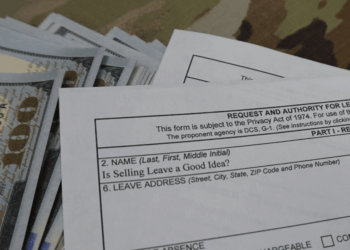The Defense Finance and Accounting Service just added an important new deadline to the military’s Survivor Benefit Plan open season. If you are eligible to revisit your SBP decision, you should do your analysis now.
The 2023 National Defense Authorization Act authorized an open season through Jan. 1. This open season allows most military retirees to opt in or opt out of the Survivor Benefit Plan without having a qualifying life event, such as a marriage or birth of a child.
However, enrollment in SBP during this open season is a multi-step process. To ensure the process can be completed before the deadline, DFAS has suggested that initial, non-binding letters of intent should be uploaded to DFAS by Nov. 1.
What is the Survivor Benefit Plan?
The Department of Defense’s Survivor Benefit Plan provides income to survivors after the death of the retiree. Military retirement pay automatically ends with the death of the military retiree. The premium-based SBP program allows service members and their spouses to purchase an extension of the military retirement pay annuity.
SBP benefits are 55% of a “covered amount” of military retirement pay. The covered amount can be from $300 to gross military retirement pay. Premiums are 6.5% for spouse coverage, with a tiny additional cost to add children as secondary beneficiaries. Child-only coverage is very inexpensive, typically a few dollars a month, and is based on the age of the retiree and the age of the youngest child.
SBP benefits and costs increase annually with the federal government’s Cost of Living Adjustment (COLA). This COLA feature provides important inflation protection for survivors receiving benefits.
Another important feature of SBP is that eligible beneficiaries may receive benefits for their lifetime. This includes surviving spouses, as long as they do not remarry before age 55, and disabled adult children. Child coverage typically ends at age 18, or age 22 if a full-time student.
SBP coverage is in full force immediately. In addition, no additional payments are due after the retiree has made 30 years of payments and is age 70. (Both things must be true.)
While the basic premise of SBP is simple, there are many details and nuances. It is vital that anyone making an SBP decision understands the program accurately. There’s a lot of misinformation out there about SBP, and there are financial advisors who will (intentionally or unintentionally) misrepresent SBP. For a list of places to learn about SBP, see 10+ Places to Learn About the Survivor Benefit Plan.
What is open season?
Under normal rules, SBP enrollment is limited to the time of retirement, with certain specific exceptions. There are few opportunities to disenroll. However, Congress authorized an open season through 2023 because of a major change in the SBP rules.
To be eligible to make a change during this open season, retirees must have been receiving retired pay, eligible members, or former members awaiting retired pay on Dec. 22, 2022. This includes retirees who were not enrolled in SBP on that date, who want to enroll, and retirees who were enrolled in SBP on that date and want to disenroll.
While the process to disenroll in SBP is relatively simple, the enrollment process has multiple steps. DFAS has announced this Nov. 1 deadline to ensure that there is ample time to complete the enrollment process before Jan. 1.
Buying into SBP might be costly
This opportunity to enroll in SBP does have a buy-in cost. New enrollees will need to pay all off the premiums that would have been paid if they had enrolled at retirement, with interest, and a small administrative fee. All back payments apply to the 30 years of payments to stop paying.
Depending on the time since retirement and the elected coverage amount, this buy-in amount could be significant. It’s important to note here that while SBP is not inexpensive coverage, you can not buy a comparable commercial annuity because the Department of Defense subsidizes approximately 40% of the cost of the SBP program. Even other government survivor benefit plans are more expensive and have smaller benefits.
Not sure what you should do?
If you are a retiree family, please take this opportunity to review your SBP decision. Many families make their original SBP decision without complete information, or the time to process all the different aspects of what SBP can and can not do as part of their financial plan. Even those who were confident in their initial decision may find that their financial situation has changed unexpectedly.
First, be sure you utilize all the resources available to understand SBP.
Then, assess the income and obligations that would be available to your survivors. For most retiree families, military retirement pay is a significant part of their total income. How would survivors manage without any of that military retirement pay? There’s no right answer here because every family has different assets, income, and liabilities.
If you’re not sure, consult with a fee-only financial planner to get an outside opinion. Make sure the planner actually understands SBP, does not have any preconceptions about the right answer for every client, and will not gain financially if you make another estate planning decision.
The decision whether to enroll or disenroll in SBP is very personal, and requires a solid understanding of your family’s financial situation and reflection on what your survivors would need. It’s not easy, and it’s not fast. With this new deadline of Nov. 1 to submit a non-binding Letter of Intent, the time to act is right now.
Read comments










































